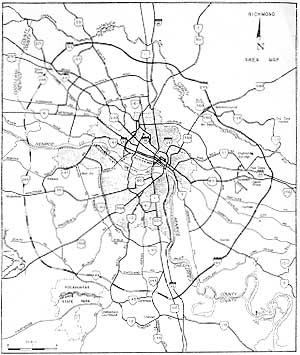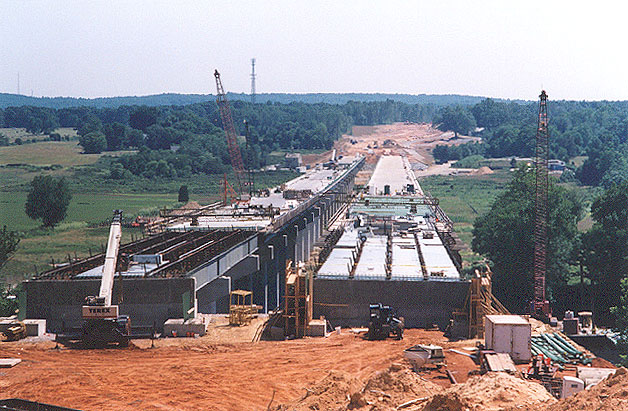| Richmond Beltway (I-295 and VA-288) |
Routes I-295 and VA-288 are freeways which comprise the beltway around Richmond, Virginia, and Route 895 is effectively part of this network. Construction began in May 2001 for all the remaining projects to complete the western portion of VA-288.
I-295 was conceived as part of the National System of Interstate and Defense Highways which was approved for 41,000 miles of routes in 1956. There were later additions, but I-295 was part of the original 1956 system. It's proposed routing was from I-64 west of Richmond, passing north and east of Richmond, to I-95 south of Richmond just north of Chester, with its southern end actually at US-1/US-301 a mile west of I-95. As an Interstate highway it qualified for 90% federal funding from the Federal Highway Administration (FHWA).
The following named report was the 1968 major thoroughfare plan for the Richmond area: Richmond Regional Area Transportation Study, Volume 5 "Recommended Thoroughfare Plan - Street Inventory, Functional Plans, and Cost Estimates", engineering report prepared in cooperation with Richmond Regional Planning Commission, City of Richmond, Henrico and Chesterfield Counties, Richmond Metropolitan Authority, Virginia Department of Highways, U.S. Department of Transportation, Federal Highway Administration, Bureau of Public Roads, and the U.S. Department of Housing and Urban Development. Prepared by consultant Wilbur Smith and Associates, 1968.
See my article "Richmond Interstates and Expressways", and the section "1968 Major Thoroughfare Plan" for more details, including a Richmond regional map with the proposed highways, including a more detailed map of the Richmond Beltway as then proposed.
In this 1968 report, the entire Richmond Beltway was shown proposed as a complete circumferential freeway around the region. The portions north of I-64 and east of I-95 were proposed as I-295, and the portions south of I-64 and west of I-95 were proposed as VA-288. I-295 from I-64 west of Richmond to VA-5 southeast of Richmond was ultimately built on essentially the same location shown on this report. The section from VA-5 to I-95 at Dutch Gap was cancelled and not built, because of unacceptable parkland impacts on the Richmond National Battlefield parkline along the battlefield road; this section would have included a fixed high-level bridge with about 150 feet of vertical clearance over the James River at Kingsland Reach. Instead, in 1978, Virginia received approval from FHWA to build the remainder of I-295 south of VA-5 along the location that it occupies today; this alignment avoids any Civil War historical resources, and it extends 22 miles from VA-5 southward to I-95 south of Petersburg, including direct access to the city of Hopewell.
In this 1968 report, the 17.4-mile-long southern portion of VA-288 was shown in the location that it was ultimately built from 1986-1989; from I-95 to VA-76 (although VA-76 Powhite Parkway had a planned western termini at US-60/Robious Road in that report). The western portion of VA-288 was shown extending from today's VA-288/VA-76 junction, through Midlothian, to the junction of I-64 and I-295 west of Richmond. After location studies in the 1970s, these route locations were approved by the Virginia State Highway Commission.
The proposed location for the western portion of VA-288 was abandoned by the Commonwealth Transportation Board (former VSHC) in 1988, due to extensive later development along portions of the route in Chesterfield and Henrico Counties (28 businesses along US-60 in Midlothian would have been razed by the original location); that is when the present western location of VA-288 was approved by the CTB, and this location passes through the eastern corner of Powhatan County and the eastern portion of Goochland County, interchanging I-64 about 1/2-mile west of the Goochland/Henrico County Line. In Goochland County, the private developer of the West Creek development offered 3.5 miles of right-of-way, free of charge, to VDOT, for the portion of VA-288 that passes through their property, and VDOT accepted the donation of the right-of-way. The western portion of VA-288 is scheduled for completion in mid-2004. A 4-lane arterial highway location was also approved by the CTB in 1989, the John Rolfe Parkway, as an extension from I-295 southward from I-64 to Gayton Road. About 1.2 mile of the John Rolfe Parkway has been built from Gayton Road to Ridgefield Parkway, but most of the parkway remains unbuilt.


